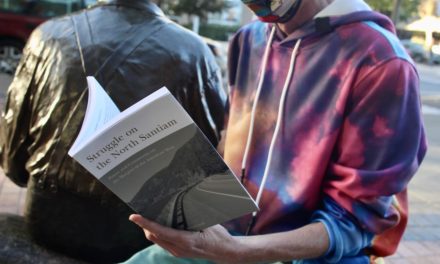(For background information on this new play and its “Rolling World Premiere” at Oregon Contemporary Theatre, click on https://eugenescene.org/oregon-contemporary-theatre-brings-a-new-play-alabaster-to-the-eugene-stage/
By Kelly Oristano
“Tell me, what is it you plan to do
with your one wild and precious life?” — Mary Oliver
In one sense, Alabaster, a new play by Audrey Cefaly onstage now at Eugene’s Oregon Contemporary Theatre, stays confined to a single small room, smaller than the OCT stage. Claustrophobic, even. In another more important sense, it goes absolutely everywhere. Cefaly’s script is experimental at every opportunity, and director Willow Jade Norton and her wonderful cast and creative team dive into the experiment head first, finding something deeply human, particular and universal, personal and communal, that will make a mark on audiences long after they leave the theater.
Also, the narrator is a goat.
The experiment starts before the show. Fiddler/violinist Rose Heising, credited as “Musician,” enters pre-show and plays a selection of moody pieces while the audience is settling. The mood the pieces desire to set might best be described as “good-naturedly disturbing.”
But Musician is not just a static functionary — she’ll walk around the set making eyes at you and your audience colleagues and then they’ll try to catch you off guard with a sudden agitated “scary” music cue. She’ll take visible pleasure in making you jump. They’ll remain onstage in costume for most of the show, providing music and atmospheric sound and generally helping this play evoke mental states that theater can sometimes be a bit hard pressed to create.
There’s a human, and humane, character-driven story that ties it all together, but the only two ‘humans’ in the play are billed last by order of appearance. Having met Musician early on, we’ll first meet our narrator Weezy, a goat, portrayed by Kamden Flowers, and Bib, also a goat, played by Marla Norton. Weezy talks. A lot, actually. And good stuff, the kind of insight you wouldn’t expect from a goat, even one you knew could talk. Bib makes (uncanny) goat noises, and is Weezy’s mother.
The billing order is a bit of a ruse, though. The story is undoubtedly about our two humans: June, the occupant of the single small room (and environs) played by Hailey Henderson, and Alice, a visiting visual artist, played by Jerilyn Armstrong. We’ll learn scads more about June and Alice over the evening than we will about Bib and Weezy, but it wouldn’t do to tell any of it here. The play sets some important rules for itself in the opening moments, and it would be wrong to deprive anyone of the joy of this discovery. Briefly and obliquely, June is traumatized and Alice is there to document it artistically, but it turns out that Alice is also pretty traumatized, and that June is no slouch of an artist.
At a deeper level than plot, the play is ‘about’ such things as: generational trauma, family patterns, grief and loss, mind/body dissonance, learning to speak your needs and learning to meet people ‘where they are,’ wanting to know the meaning of life, and wanting to live a life with meaning. Which, if that seems overwhelming, there is a bit of overwhelm intended by the script and by the production. It’s deep, and deeply layered, and disorienting to get lost in.
And fun, with goats.
Being unable to discuss character or story further allows us to move directly to production and performance. Director Norton has taken a series of daring risks to bring Alabaster to fruition. “Musician,” for example, is not a scripted character. It’s a device Norton knew she needed to realize her vision, and she worked with the playwright to make it happen in a way that served Cefaly’s vision as well.
Norton also experiments with presentational styles, moving tautly from fine wrought naturalism to magic realism to a dream ballet to stark expressionism; at points the play aggressively breaks the 4th wall and then asks the audience to build it back up while the action continues apace.
Amy Dunn’s set and Emily Bolivar’s lighting design are as experimental as the script under Norton’s steady hand. The lighting makes one wonder if there are hidden images or messages painted on the set that only appear at certain points. The set itself is gorgeous and evocative and just the right little bit creepy. Erin Wills’ costumes and Gina Love’s impressive makeup skills are important and well executed parts of the full collaborative plan. The overall effect from this exceptional team’s effort is a viscerally and philosophically urgent production.
Alabaster, perhaps especially Norton’s Alabaster, demands a cast that can meet the moment. This ensemble is near-perfect. Musician Rose Heising adds more than sound and mood. As she perambulates the stage, their reactions to onstage events alter the stage picture and enhance the emotional context. Her inclusion in the drama is a lovely touch. Marla Norton’s Bib traps your attention wordlessly. Often, June and Alice are getting into it as humans in the small room, and one finds one’s self checking in to see “how Bib feels about all this.” When Bib does get her moment to take over the stage, it’s a moment of glorious real theater magic.
Hailey Henderson and Jerilyn Armstrong are excellent actors as individuals. As a duo in this play they are, to borrow a phrase, straight fire. Two fully lived-in performances so fully living into each other’s performances is a rare and inspiring thing to see. Henderson’s June requires almost every note, tone, and color that her instrument is capable of, reminiscent of the way Regina Spektor uses her whole voice, not just the “pretty” parts. Armstrong gives Alice a unique presence and has a command of the stage and of herself that the character requires. One can intuit from their shared performance how much individual work they did with these characters and this demanding piece to be able to come to the process and breathe real life into it. A perceptive viewer will come away from Alabaster with a deep appreciation not only of these performances but of the work that made them.
Jimmy Cagney said the secret to acting was to “walk in, plant your feet, look the other fellow in the eye and tell the truth.” Kamden Flowers walks onstage at lights up, looks at the back row, and says “I’m a goat,” and the truth of the statement is simply impossible to deny for the next two hours. It’s a remarkable and impressive performance, all the more remarkable for how little chicanery there is to it. She wears no horns or fur, just clothes. No hooves, no particular goat voice, just the occasional moment of physicality that implies she might not be as dextrous as a human, and an earnest, simple, funny performance that comes from her heart and will go straight into yours.
Leaving the theater, your reviewer and his date (who gets full credit for the Mary Oliver epigraph above) attempted to distill the play’s thesis and arrived at something like this: “Life is bad and objectively getting worse. More, as you age and gain perspective you become better able to discern this fact. The only non-destructive antidote to this,” Alabaster might have it, “is to make art while you can and live a life in mutual service to others.”
Hearing that out loud, we realized it was eerily close to the meaning of life, and I think that is the mark of a very good play.
Albaster continues at Oregon Contemporary Theatre
When: 7:30 p.m. on May 26-28, June 2-4; 2 p.m. matinees on May 29 and June 5; streaming available on demand through June 5
Where: Oregon Contemporary Theatre, 194 W. Broadway, Eugene
Tickets: $20-$44 in-person performances; $20 for streaming online, available through the box office at octheatre.org or 541-465-1506









